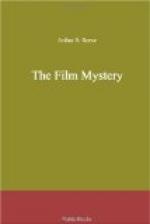Marilyn Loring was a surprise to me. Stella Lamar both on the screen and in real life was a beauty. In the films Marilyn was a beauty also, apparently of a cold, unfeeling type, but in the flesh she was disclosed as a person utterly different from all my preconceived notions. In the first place, she was not particularly attractive except when she smiled. Her coloring, hair frankly and naturally red, skin slightly mottled and pale, produced in photography the black hair and marble, white skin which distinguished her. But as I studied her, as she was now, before she had put on any make-up and while she was still dressed in a simple summer gown of organdie, she looked as though she might have stepped into the room from the main street of some mid-Western town. In repose she was shy, diffident in appearance. When she smiled, naturally, without holding the hard lines of her vampire roles, there was the slight suggestion of a dimple, and she was essentially girlish. When a trace of emotion or feeling came into her face the woman was evident. She might have been seventeen or thirty-seven.
To my surprise, Kennedy made no effort to elicit further information concerning the personal animosities of these people. Perhaps he felt it too much of an emotional maze to be straightened out in this preliminary investigation. When he found Marilyn had watched the taking of the scenes he compared her account with those which he had already obtained. Then he dismissed her.
In rapid succession, for he was impatient now to follow up other methods of investigation, he called in and examined the remaining possible witnesses of the tragedy. These were the two extra players—the butler and the maid, the assistant director, Phelps’s house servants, and Emery Phelps himself. For some unknown reason he left the owner of the house to the very last.
“Why did you wish these scenes photographed out here?” he asked.
“Because I wanted to see my library in pictures.”
“Were you watching the taking of the scenes?”
“Yes!”
“Will you describe just what happened?”
Phelps flushed. He was irritated and in no mood to humor us any more than necessary. A man of perhaps forty, with the portly flabbiness which often accompanies success in the financial markets, he was accustomed to obtaining rather than yielding obedience. A bachelor, he had built this house as a show place merely, according to the gossip among newspaper men, seldom living in it.
“Haven’t about a dozen people described it for you already?” he asked, distinctly petulant.
Kennedy smiled. “Did you notice anything particularly out of the way, anything which might be a clue to the manner in which Miss Lamar met her death?”
Phelps’s attitude became frankly malicious. “If I had, or if any of us had, we wouldn’t have found it necessary to send for Prof. Craig Kennedy, or”—turning to me—“the representative of the New York Star.”




